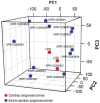Genomic Landscape Comparison of Cardiac versus Extra-Cardiac Angiosarcomas
- PMID: 38137511
- PMCID: PMC10741871
- DOI: 10.3390/biomedicines11123290
Genomic Landscape Comparison of Cardiac versus Extra-Cardiac Angiosarcomas
Abstract
Angiosarcomas (ASs) are rare malignant vascular entities that can affect several regions in our body, including the heart. Cardiac ASs comprise 25-40% of cardiac sarcomas and can cause death within months of diagnosis. Thus, our aim was to identify potential differences and/or similarities between cardiac and extra-cardiac ASs to enhance targeted therapies and, consequently, patients' prognosis. Whole-transcriptome analysis of three cardiac and eleven extra-cardiac non-cutaneous samples was performed to investigate differential gene expression and mutational events between the two groups. The gene signature of cardiac and extra-cardiac non-cutaneous ASs was also compared to that of cutaneous angiosarcomas (n = 9). H/N/K-RAS and TP53 alterations were more recurrent in extra-cardiac ASs, while POTE-gene family overexpression was peculiar to cardiac ASs. Additionally, in vitro functional analyses showed that POTEH upregulation conferred a growth advantage to recipient cells, partly supporting the cardiac AS aggressive phenotype and patients' scarce survival rate. These features should be considered when investigating alternative treatments.
Keywords: bioinformatics; cardiac angiosarcomas; extra-cardiac angiosarcomas; whole-transcriptome sequencing.
Conflict of interest statement
The authors declare no conflict of interest.
Figures






References
-
- Fayette J., Martin E., Piperno-Neumann S., le Cesne A., Robert C., Bonvalot S., Ranchère D., Pouillart P., Coindre J.M., Blay J.Y. Angiosarcomas, a Heterogeneous Group of Sarcomas with Specific Behavior Depending on Primary Site: A Retrospective Study of 161 Cases. Ann. Oncol. 2007;18:2030–2036. doi: 10.1093/annonc/mdm381. - DOI - PubMed
Grants and funding
LinkOut - more resources
Full Text Sources
Research Materials
Miscellaneous

